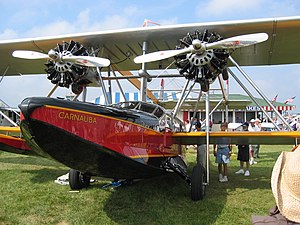Sikorsky S-38
| Sikorsky S-38 | |
|---|---|
 Replica of the S-38 Spirit of Carnaúba |
|
| Type: | Amphibious aircraft |
| Design country: | |
| Manufacturer: | |
| First flight: |
June 25, 1928 |
| Commissioning: |
October 1928 |
| Number of pieces: |
Max. 120 |
The Sikorsky S-38 was an amphibious aircraft made by the US manufacturer Sikorsky Manufacturing Co. , which operated as the Sikorsky Aviation Division of the United Aircraft and Transport Corporation from 1929. The S-38 was after the S-34 , which was built only once, and the S-36, which was produced in five copies, the first Sikorsky aircraft to be built in larger numbers. Occasionally it was also called The Explorer's Air Yacht .
history
In essence, the S-38 was a 30% larger S-36 with twice the power and three times the range. In order to keep the proportions similar to the S-36, the engines were hung on struts under the wings. The fuselage had a wooden structure planked with duralumin . The first flight took place on June 25, 1928.
Sikorsky received eleven orders for the first production version, the S-38A. Customers were NYRBA for its South America routes, Pan American Airways for the Caribbean routes and Western Air Express for flights to Catalina Island . The US Navy also received two S-38A, which it designated as PS-2 . One copy went to the US Army Air Corps as the XC-6 and a luxury version went to the American diplomat and publisher John H. Whitney .
The main production variant S-38B was introduced at the end of 1928 with slightly more powerful engines and larger fuel tanks. Around 100 of these had been delivered by 1932. The majority of them in turn to NYRBA, Pan American, Western Air Express, Northwest Airways and the Curtiss Flying Service. The US Navy also received four S-38Bs between 1929 and 1932 under the designation PS-3 .
The last variant was the S-38C, which was designed with smaller fuel tanks and two additional seats for short-haul use. Operators were Inter-Island Airways, whose lines connected the four Hawaiian Islands, and Colonial Western Airways, which operated in the Great Lakes area . After the US Navy received its PS-2 and PS-3, it removed the machine-gun armament in the bow and stern and reclassified the six aircraft as transport aircraft in 1931 with the new designations RS-2 and RS-3 (see also designation system for US Navy aircraft from 1922 to 1962 ). Two more S-38Bs were delivered directly to the US Marine Corps (USMC) and one to the Navy as a transport version .
The Navy and USMC retired their S-38s in the mid-1930s, while private owners continued to use them until the early 1940s.
Pan Am
The first S-38 with the aircraft registration NC8000 entered service with Pan American Airways on October 31, 1928. Pan Am was the largest operator of the S-38 with a total of 38 purchases, some of which were also acquired second-hand by other companies. At times 30 machines were in use at the same time.
Historic flights of the S-38
- Charles Lindbergh flew with Anne Morrow Lindbergh for Pan Am South America and Pacific routes .
- Newspaper publisher Robert R. McCormick flew commercial routes between North America and Europe .
- John Hay Whitney , a venture capitalist, used the plane for luxury travel.
- The Flying Hutchinsons were the first family to circumnavigate the world.
- Filmmakers Martin Johnson and Osa Johnson flew an S-38 (NC29V) "Osa's Ark" in "zebra paint" for flights in northern Kenya and Tanganyika .
- Herbert Johnson researched carnauba wax in South America with the plane "The Spirit of Carnaúba". An airworthy replica machine still exists today.
- Howard Hughes bought an S-38 to fly around the world.
One of the two S-38 (N28V) still in existence today was used in the 2004 film Aviator . However, Hughes actually flew an S-43 at the time .
In August 2010, Tom Schrade from Las Vegas , Nevada crossed the Atlantic in several stages via Greenland and Iceland. The aircraft with two replica Pratt & Whitney engines, each with an output of 400 hp, was named Osa's Ark and the aircraft was painted in zebra from the 1930s.
The information on the total number of machines built varies in the literature between 90 and 120 copies. These were assembled in Stratford, Connecticut .
Technical specifications
| Parameter | Sikorsky S-38A data |
|---|---|
| crew | 2 |
| Passengers | 10 |
| length | 12.27 m |
| span | 21.85 m |
| Wing area | 68.6 m² |
| height | 4.22 m |
| Empty mass | 2727 kg |
| Takeoff mass | 4764 kg |
| Top speed | 192 km / h |
| Service ceiling | 4878 m |
| Range | 1200 km |
| Engines | 2 × Pratt & Whitney R-1340 Wasp each 298 kW (400 PS) |
Web links
literature
- ER Johnson: American Flying Boats and Amphibious Aircraft , McFarland and Co., 2009, ISBN 978-0-7864-3974-4 , pp. 72-74
- REG Davies: PAN AM An Airline and its Aircraft , Hamlyn, 1987, ISBN 0-600-55671-9 , p. 12 f.
- John M. Andrade: US Military Aircraft Designations and Serials since 1909 , Midland Counties Publ., 1979, ISBN 0-904597-22-9 , pp. 207, 218

